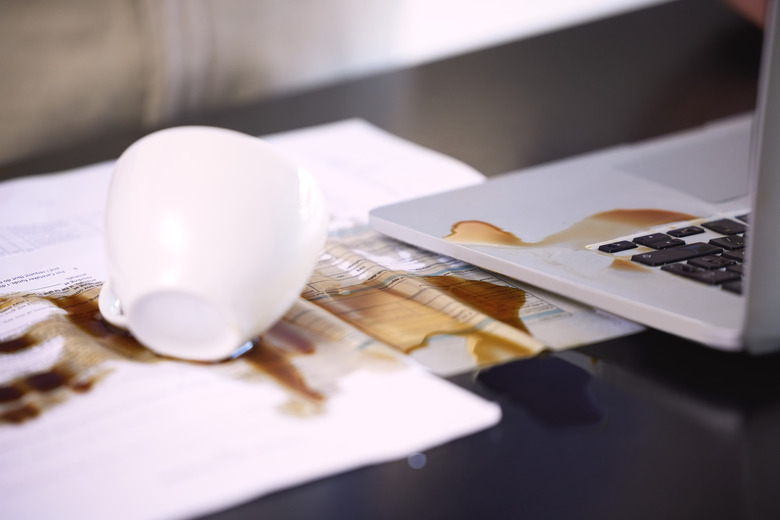How To Remove Stains From Paper
We may receive a commission on purchases made from links.
It can be easy to accidentally spill something, like coffee or tea, on important papers or documents, and even water can cause stains and damage. It is also possible for dust or mold to stain papers after years of storage or for air and moisture to be absorbed into papers over time if the papers are not stored in an airtight container. But don't worry — you may be able to clean and preserve these important paper items by following a few simple steps.
Start With Surface Cleaning
Start With Surface Cleaning
Surface cleaning is great for cleaning, maintenance, and conservation of important papers, documents, or artwork and crafts, although this method only works for nonliquid stains. It involves cleaning paper without water or solvents and can be used to clean away many dry deposits, such as dust, dirt, mold, and accretions, which consist of solid foreign matter attached to the surface that can be waxy or sticky in texture, possibly building up over time.
Tip
As with many forms of cleaning, before you start surface cleaning paper, do a test on a small, unnoticeable area, such as a corner or on the back, before cleaning the entire surface. Do this test very gently to see if there are any smears or tearing and proceed (or not) accordingly.
Brush Away Surface Dirt
First brush away loose surface dirt. If the paper seems strong enough to handle surface cleaning, lay it out as flat as you can on a clean, hard surface; you need to have as few wrinkles and ridges in the paper as possible. Clean the paper by lightly brushing away any dirt or dust with a soft brush. Soft brushes can include paintbrushes and specialty brushes designed for this purpose.
If there is a lot of debris coming from the paper, you can use a HEPA vacuum to clean up the grime by sweeping it toward the vacuum on the table. Never put the vacuum directly on top of the paper, though, as the suction is too strong and can quickly damage the paper. Before you begin, place a piece of cheesecloth or another breathable fabric over the nozzle of the vacuum so that if the paper tears, pieces do not get sucked into the vacuum. If stains and debris are not removed via brushing alone, try some deeper-cleaning methods.
Remove Accretions and Sticky Substances
If material is stuck on and cannot be removed with a soft brush, you may need to remove it with an implement. These stubborn deposits can include residual adhesive from old tape, wax, or even food. You can try to gently lift these stains off with the head of a needle, micro-spatula, butter knife, or another small implement. For adhesive residue left behind by old tape, gently rub it with a rubber cement pickup eraser using small, light strokes and then peel any loosened adhesive from the eraser.
For crusty dried-on food stains, try to break them first by applying gentle downward pressure, which can crack the accretion. If you are able to break the crust, then you can surface clean as much as possible with a soft brush.
Clean Moldy Paper
Surface cleaning can be used for mold, but first deactivate the mold as a safety precaution so that you do not breathe in spores or have an allergic reaction. Do this by wrapping the paper or document in waxed paper and freezing it in the freezer for 48 hours. Only after freezing can you proceed with brushing away the mold and using a vacuum to clean up the mold so it does not stay in your home. You may also want to wear a dust mask and goggles to prevent inhalation or eye irritation from the mold.
Address Liquid Stains
Address Liquid Stains
Liquid stains, such as coffee, tea, or wine, can be tricky and can also leave the paper crinkly. One method is to use a damp paper towel to gently blot the dried stain. The water rewets the stain, and you may be able to remove some of it this way. You will need to use several paper towels to achieve this. The stain should transfer to the paper towel as you dab. Do not scrub or rub, as this may harm the paper. If this does not work, you can try using white vinegar.
Clean With White Vinegar
If a water-moistened paper towel does not get the job done, try adding vinegar. First dilute the vinegar by making a solution of equal parts vinegar and water. White vinegar is recommended because it is clear and colorless. You do not want to inadvertently create a new stain by using vinegar that is not colorless.
- Use a cotton ball with a small amount of the vinegar solution to gently test a small, unnoticeable area of the paper.
- Test an area with ink if to see if the ink runs or rubs off on the cotton ball; if so, stop using this method.
- If the vinegar works well with the ink and document, continue very gently dabbing the paper, but do not rub as this could potentially cause smudging or tears.
- Use a clean vinegar-moistened cotton ball from time to time to help absorb the stain and avoid smearing it.
Dry the Paper
Once you are done with wet cleaning, dry the paper by blotting it using a clean, dry paper towel. Then allow the paper item to air-dry. To prevent crinkles and curling, use clean paper weights or other items to weigh the paper down and keep it flat.
